The OnePlus 2 Review
by Brandon Chester on December 14, 2015 8:00 AM EST- Posted in
- Smartphones
- Mobile
- OnePlus
- OnePlus 2
GPU Performance
While general performance on the OnePlus 2 ends up being quite disappointing, when focusing on GPU performance we can hope for a much more appealing outcome as Adreno 430 continues to be one of the best GPUs you can get in a mobile device. While I don't expect there to be a large deviation from the performance of other Snapdragon 810 devices, given the unexpected difference with JavaScript and general CPU performance it's worth running the OnePlus 2 through our standard GPU benchmarks to confirm that everything is performing as expected. As always, we start off with 3DMark, followed by BaseMark X and GFXBench.
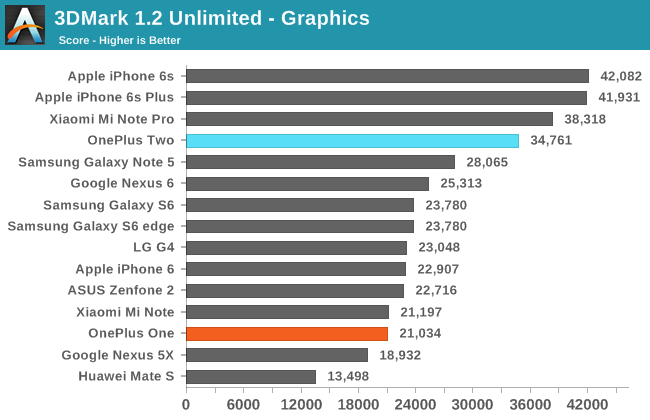

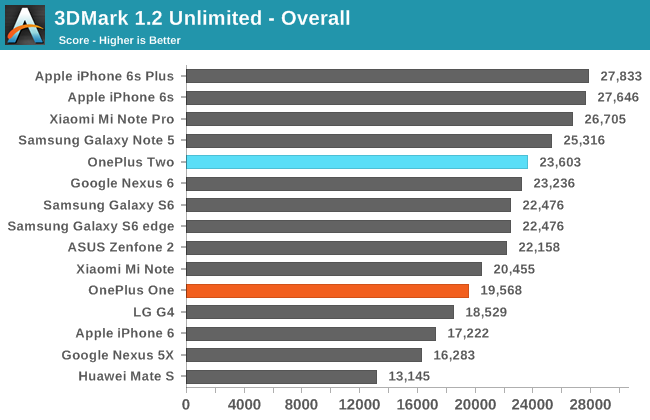
Snapdragon 810's Adreno 430 GPU is still very fast, and it achieves a very high score in 3DMark's graphics test. As usual, the physics test score basically just scales with frequency and number of cores in use, and with the big cores on the SoC throttling down we see a fairly low result there. I don't usually care much for the overall score, but since it's a weighted average we see the OnePlus 2 sitting near the Nexus 6, although in workloads that mainly stress the GPU you'll actually see a much larger gap between the two.
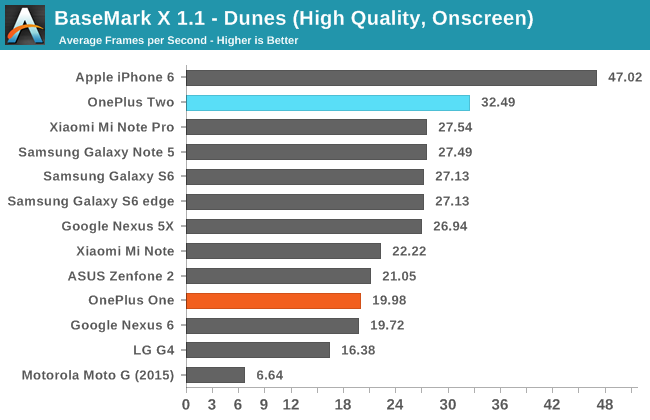
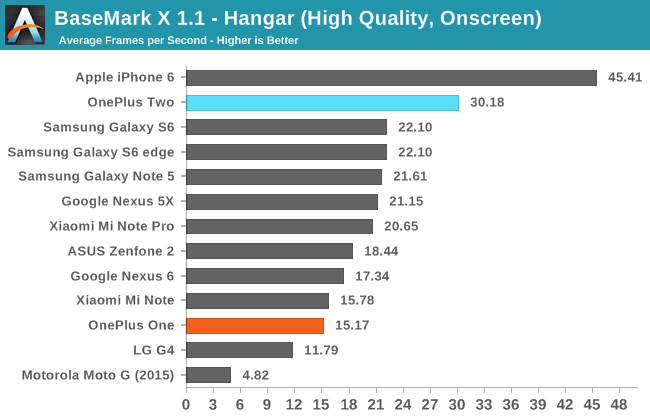
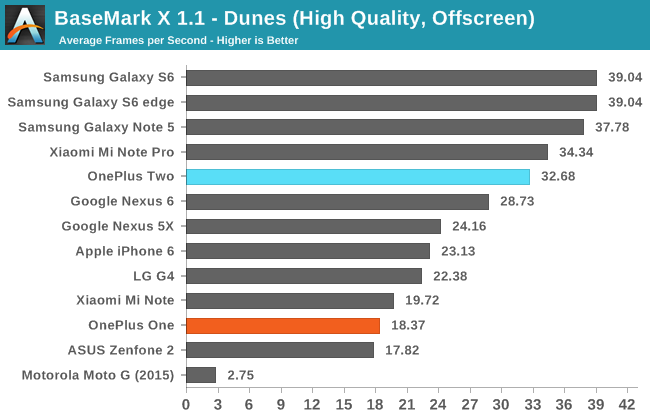
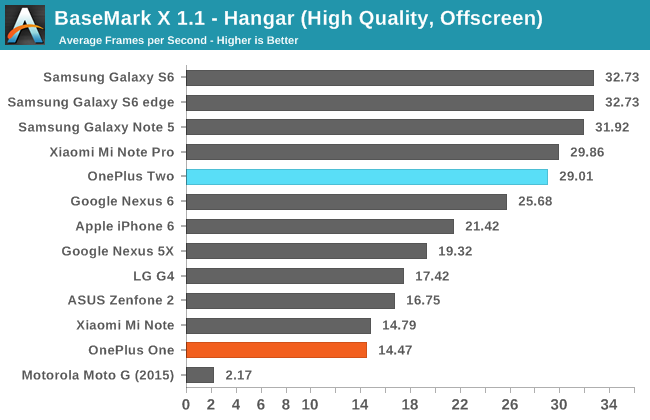
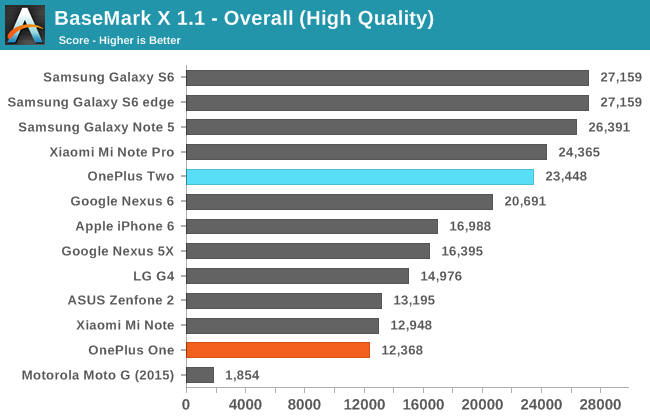
The OnePlus 2 performs very well in BaseMark X, tracking slightly behind the Mi Note Pro which we previously noted may have some level of additional optimizations at the driver level compared to the other Snapdragon 810 implementations. The improvement over the OnePlus One with its Adreno 330 GPU is quite large, with there being nearly a doubling in performance in the Hangar benchmark.

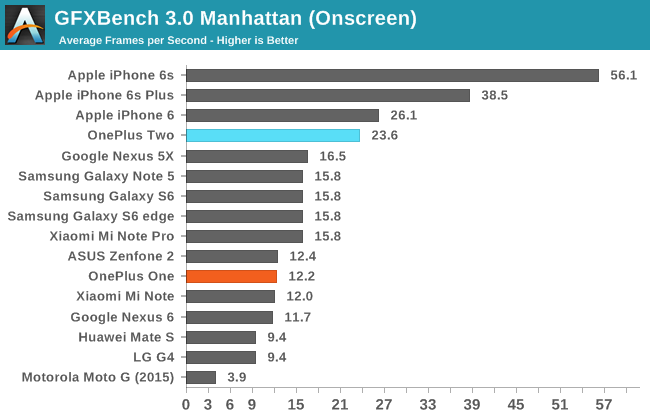

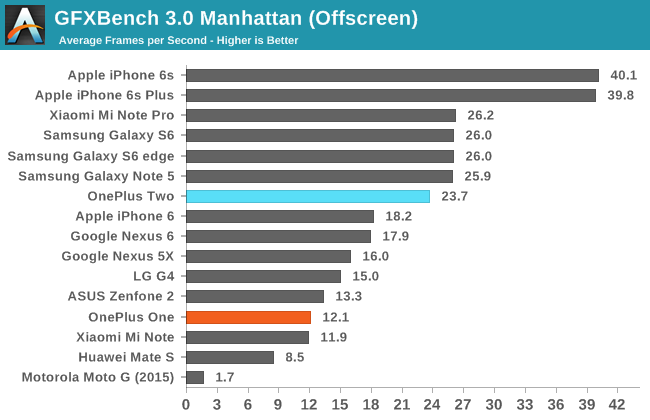
GFXBench's off screen performance results show that the OnePlus 2 is again a bit slower than the Mi Note Pro. In any case the performance is still very good and only really beaten by Samsung's Exynos 7420 devices, and the iPhone 6s. Since the display resolution is only 1080p you actually get better performance in games that run at native resolution than the Mi Note Pro and Galaxy Note5.
Adreno 430 has always been a good GPU, and in general the GPU performance of Snapdragon 808 and 810 hasn't really suffered in the same way the CPU performance has. At $400 the OnePlus 2 definitely gives you a lot of GPU power, and it's something that differentiates it from what's available at lower prices, and even other devices at the same price like the Nexus 5X.
NAND Performance
NAND performance is becoming a greater focus in mobile devices. To improve performance, vendors like Samsung and Apple have turned to solutions outside of the eMMC storage that is typically used in mobile devices. However, the vast majority of products still use eMMC NAND, and in some cases the performance of that NAND can be low enough to introduce noticeable performance issues when using a device. The OnePlus Two uses a Samsung CGND3R eMMC 5.0 NAND solution, which is the same as the one used in the Mi Note Pro.

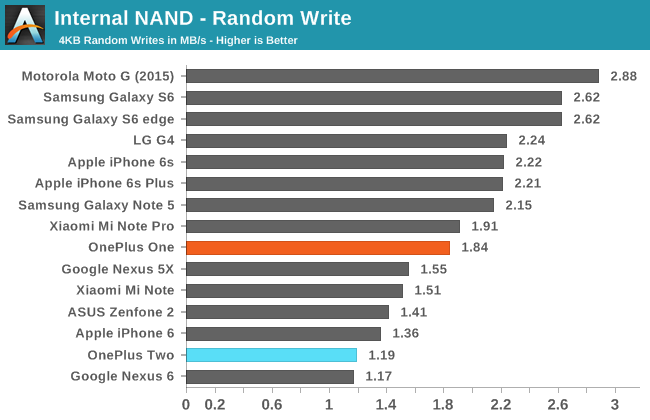
Random read speeds track closely with the Mi Note Pro. Random writes end up being quite a bit slower, and this occurs even with repeated tests so I'm not sure exactly what's causing it.
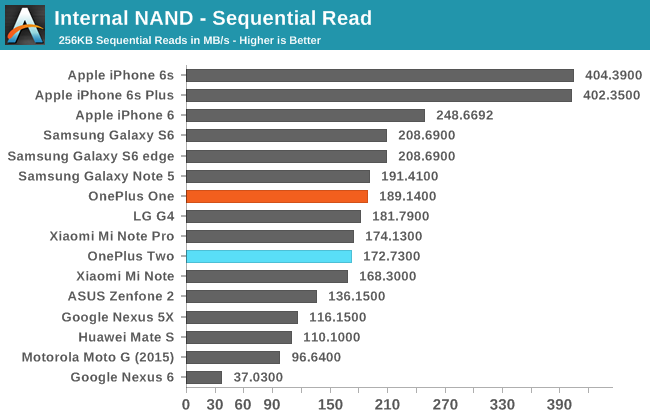
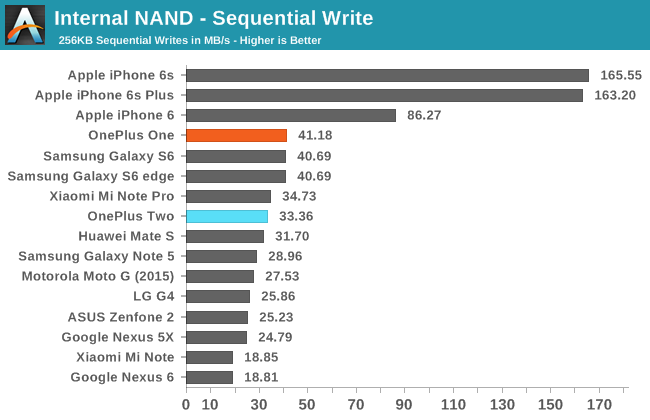
As expected, sequential read and write speeds track almost exactly with the Mi Note Pro. While the results are nothing ground-breaking, they're in line with what you get from an eMMC 5.0 NAND solution. In most cases another component of the phone will likely end up limiting performance before one runs into issues due to NAND speeds, but you won't see some of the benefits that you get with extremely fast NAND such as extremely quick app installation times, faster media transfers, etc.










132 Comments
View All Comments
tipoo - Monday, December 14, 2015 - link
It's basically running like a Snapdragon 410 on web browsing since it doesn't turn on the A57 cores? That's...Errm...Suboptimal. OnePlus did say they were sorting out the S810 throttling through software - I didn't think they meant by just not using the big cores!Granted, web browsing is so network bound with modern CPUs, maybe that's relatively ok as the wifi battery life is indeed decent.
tipoo - Monday, December 14, 2015 - link
Actually nevermind the last, as the author said it even felt slower. That's just screwey on Oneplus's side.tipoo - Monday, December 14, 2015 - link
"Even with that, it's not exactly clear to me what additional factors make the Snapdragon 808 and 810 devices all perform so poorly here compared to a device like the Moto G which just has 4 Cortex A53 cores. "Could there be any differences in how the SoC provides bandwidth to the A53s, since they're just backup in the 810 but the only CPUs in the 410? Are the cache configurations the same too?
lucam - Monday, December 14, 2015 - link
Dear Anand on regard to GPU performance, why don't you start using 3D Mark Slingshot which runs at 1080p and uses Open GL 3.0 rather than the Ice storm which starts to be old (720p, Open Gl 2.0).And for the GFXBench 3.0, maybe you can start using the 3.1 version of Manhattan as well, more intense. I believe you know there is the IOS version of Manhattan 3.1 as well now.
Ryan Smith - Monday, December 14, 2015 - link
All of our mobile benchmarks are set to be overhauled for 2016. We're just at the end of the year, so it's the latest point in the calendar.lucam - Monday, December 14, 2015 - link
Excellent!!tipoo - Monday, December 14, 2015 - link
(Anand doesn't work here anymore :P )lucam - Monday, December 14, 2015 - link
You are right and I've totally forgotten that :)Where is he actually?
Araa - Monday, December 14, 2015 - link
He works for Apple nowikjadoon - Monday, December 14, 2015 - link
I wonder if he is secretly responsible for the stellar sequential write performance on the iPhone 6 lineup.